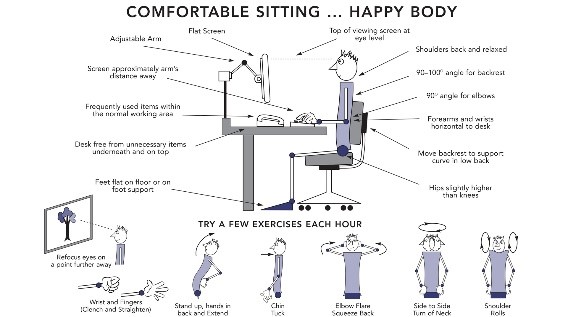Nowadays our way of living is more passive than ever. There are lot professions which use various electronic devices to help and get the job done properly. This trend impacts even children in the classroom. But that also has a, negative influence’’ on our health condition. One of the most affected body parts with this so called, modern age disease’’ is the back. Sitting is the most common culprit. Long and incorrect sitting can create weakness in our muscles (back, abdominal, gluteal and leg muscles), poor peripheral blood circulation, poor lungs ventilation, … Less physical activities can certainly influence our body weight, and increased body weight leads to worsening symptoms. So people who are required to sit for long periods of time or in incorrect seating are more exposed to these problems.
When talking about children, we need to mention increased use of computers and tablets for school work, in their spare time, and during recreational activities. Parents should be aware that excessive time spent in incorrect body positions can be harmful for children. Long periods of sitting daily can cause decreased heart and brain function (slow circulation), improper lung ventilation, slow digestion, and obesity. Children who are sedentary for too long can experience posture problems like neck and shoulder strain and back problems including pain and weak muscles (scoliosis, kyphosis, loose abdominal muscles, low back pain). Parents should look at the posture of their children and if they notice some changes, consult a healthcare practitioner or PE teacher for advice. These problems are not harmless or irrelevant and can negatively influence a children’s growth and development. Spinal deformities, weak muscles, and childhood obesity can all be linked to a sedentary lifestyle that features too much time sitting.
We all should encourage our children to take breaks during long sitting periods and do some movement. Established advice is 30 to 60 minutes per day of some physical activity. That could be activities like walking, riding a bike, slow running, stretching exercises, walking up and down stairs, climbing up a slide instead of sliding down, swinging, crab walking, jumping jacks, skipping rope, etc. Swimming is also highly recommended. One great free resource for movement breaks at home or in the classroom is Go Noodle (www.gonoodle.com). Your child can also exercise while seated (stretching and breathing exercises).
Always check that your child is seated in the correct position, which means:
• Elevate feet from the floor at less than a 20° angle (books or cushions can be used for elevation)
• Lean back on the chair’s backrest
• Do not fold legs under bottom
• Do not hook shins and feet under the chair on which they are seated.
Adults often complain about back problems, which are typically neck or low back pain problems. With time, symptoms can worsen and pain can radiate all the way through a person’s arms and legs. That level of severity certainly reduces effectiveness in the workplace and quality of life in general. All around the world, employers and employees try to find the best models to organize their workplaces and activities to decrease that negative health influences’. There are two steps we can take to achieve that.
One is to adjust work environment and the other is to do a few exercises during worktime. If you are sitting a long time at work you should consider adjusting the height of your desk, the position and angle of your computer or other electronic device, and use accessories such as wrist or arm supports if it is necessary. When seated, lean your back fully on the backrest of the chair (back support part of the chair). Do not position your shins under the chair or sit on your bent legs; try to put your feet on a platform at a 15-20° angle with the floor, and wear comfortable clothing and shoes.
Next are exercises. Performing physical exercises during the day helps to decrease symptoms, improve physical abilities, prevent possible future problems, and increase work efficiency. They can be performed in a chair at your desk, at the chair using it as a support, or simply stand up and do your exercises in a free space. Stretching is a main component of these exercises, then comes strength and endurance. You can stretch your upper or lower limbs, use some weight accessories for strength, and do as many repetitions as you can for endurance. Start with short duration, no/low weight, and fewer repetitions for start and then increase over time to avoid muscle inflammation, muscles spasms (higher muscle tone), fatigue, and pain.
We all should have regular physical activity, especially those of us who are sitting too long or in an inadequate way. In order to prevent pain, deformities, weakness, and poor work efficiency we can adjust our work space and exercise at work. However, before beginning any exercise at work, consider your present health condition. If you are currently experiencing pain or other symptoms, have a medical condition that could affect your physical abilities, or are just not “in shape, “ask for advice from a qualified healthcare professional or physical trainer first.






